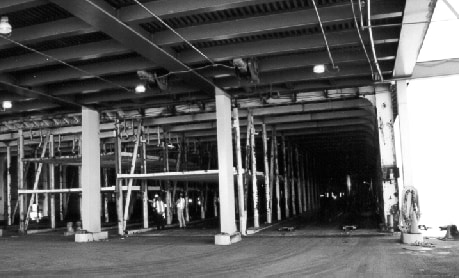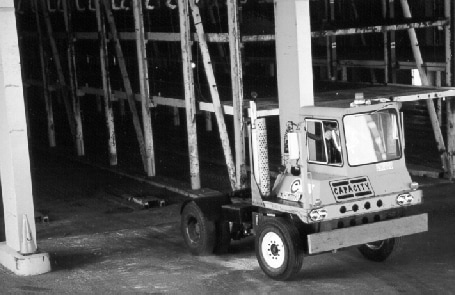Marine Terminal Laborer Run Over by a Trailer Being Loaded Onto a Barge
FACE 98-NJ-071-01
April 28, 1999
On August 7, 1998, a 34-year-old laborer at a marine shipping terminal was critically injured after he was run over by a trailer being backed into a barge. The incident occurred as a massive seagoing barge was being loaded with cars and trailers for transport to the Caribbean. The victim was apparently standing in a loading lane to strap down a pickup truck. A tractor was being backed down the lane and struck the victim, running over his legs and severely injuring his pelvis. He died seven days later of complications related to his injuries. To prevent similar incidents in the future, NJ FACE recommends the following safety guidelines:
- Employers should develop written procedures for ensuring safe working clearances for loading and unloading barges.
- Employers should instruct the truck drivers to connect the electrical lines between the hustler trucks and trailers.
- Employers should ensure that all hustler trucks are periodically inspected to ensure that safety devices are working properly.
- Employers should become familiar with available resources on safety standards and safe work practices.
INTRODUCTION
On August 17, 1998, NJ FACE investigators were notified by the county medical examiner’s office of a worker who died of injuries suffered in an industrial accident. Injured on August 7, the victim died on August 14, 1998. FACE investigators contacted the area OSHA office and arranged a concurrent investigation with the OSHA compliance officers on August 20 and 21. During the site visit, FACE investigators interviewed the employer’s representatives and examined the terminal area and truck. The barge was observed when it returned to the terminal the following day. Additional information on the incident was gathered from the OSHA compliance officer, the police report, and the medical examiner’s report.
The employer was an marine shipping service that transported cars, trailers, and shipping containers. In business since 1892, the family-owned company had been shipping barges for the past 25 years and owned seven shipping terminals in the US and several others in the Caribbean. The company employed a total of about 3,500 workers, including 40 regular full-time employees at the incident site. An additional 30 temporary or “casual” workers were hired as needed for loading and unloading the barges. Most employees (including the casuals) were unionized and were trained by the local unions.
The victim was a 34 year-old casual laborer who had worked for the company since April 1998. Hired from the union hall, the victim worked a maximum of one day a week when a barge arrived at the terminal. He was married with three children.
INVESTIGATION
The incident site was a barge shipping terminal located on an island in a large river. This facility had a single dock with a multi-level loading ramp, a large parking lot for storing trailers and cars, and the business offices. A massive shipping barge docked at the facility once a week from it’s Caribbean terminal. The barge measured 730 feet long by 100 feet wide and contained three decks that were capable of holding 350 trailers and 500 cars (see photos). Each deck had eight narrow lanes separated by concrete curbs. Loading was done from the barge’s open stern that connected to the loading ramp on the dock. The ramp connected to all three decks at once, allowing the company to unload two or three decks at the same time. The center four lanes on the bottom deck had additional levels for holding cars and required a special mobile ramp to load. The unmanned barge was towed between terminals by a 9,000 horsepower tugboat.
The incident occurred on Friday, August 7, 1998 after a loaded barge arrived at the terminal. After tying off the barge and adjusting the ballast so that it was even with the dock, the truck drivers started to unload the trailers. They used “hustlers” to move the trailers, which were trucks equipped with low gear transmissions. This gave the hustler enough power to pull the heavy trailers up the loading ramps but not enough speed to be used on the highways. The trailers were unloaded by backing the hustler down a barge lane until it contacted the stand that held the front of the trailer. This “pullman” stand was welded to the barge deck and is designed to collapse out of the way as the hustler hooked onto a trailer. The driver then connected the pneumatic brake line to the trailer, pulled it out of the barge, and parked it in a nearby lot. The hustler trucks were equipped with backup alarms and flashing warning lights.
No one witnessed the incident. Following their usual procedure, the shipping company hired the victim and other casual workers from the local maritime union hall. These employees only worked long enough to unload and load the barge, usually a single 12-14 hour shift. Starting work at 2:00 a.m., the victim was assigned to the crew which unloads and loads the cars onto the bottom deck car lanes. A ramp was set and the victim unloaded the cars by driving them off the barge. New cars were then loaded by backing them into the car lanes. Once the lane was full, the final four cars were secured to the deck with tie-down straps. At about 2:25 p.m. the victim was working on a pickup truck in the fourth slot of the bottom car lane. This lane was separated from an adjacent trailer lane by a 24 inch wide curb. Stanchions (support pillars) for the barge were located on the curbs and were used as tie-down points for the cars. The victim was tying down the pickup to a stanchion as a trailer was being backed down the adjacent lane. He apparently was kneeling or bending when he was struck by the truck which ran over his legs. The driver reported that he did not see the victim until after he had run over him. EMS technicians and the police arrived to find the victim conscious and in severe pain. He was transported to the local trauma center where he was admitted with severe leg and pelvic injuries.
He underwent surgery which included amputating one of his legs, but his condition deteriorated over the following days. The victim died of complications related to his injuries on August 14, 1998.
CAUSE OF DEATH
The county medical examiner determined the cause of death to be from “multiple trauma to the leg and pelvis with sepsis.”
RECOMMENDATIONS/DISCUSSIONS
Recommendation #1: Employers should develop written procedures for ensuring safe working clearances for loading and unloading barges.
Discussion: The very narrow traffic lanes in the barge did not leave any room for the victim to work as the trailer was being loaded. To prevent future incidents, FACE recommends that the employer develop procedures for working safely in the barge. One such procedure would be to prohibit any workers from being in the barge during trailer loading, or to block off one or more lanes between the workers and trailers to provide a buffer or safety zone. All employees must then be trained on these procedures which must be enforced by the supervisors.
Recommendation #2: Truck drivers must be instructed to connect the electrical lines between the hustler trucks and trailers.
Discussion: It was noted during the site visit that the truck drivers connected the pneumatic brake line but not the electrical line from the hustler truck to the trailer. This provided the trailer with compressed air for braking but no electrical power for operating the brake or reverse lights. The extra light from the trailer’s reverse and brake lights will increase visibility for drivers, spotters, and others working nearby.
Recommendation #3: Employers should ensure that all hustler trucks are periodically inspected to ensure that safety devices are working properly.
Discussion: The examination of the hustler truck found that the yellow strobe warning light on the truck’s roof was not operating. FACE recommends that all warning lights, alarms, and other safety devices be regularly inspected to ensure that they are working properly.
Recommendation #4: Employers should become familiar with available resources on safety standards and safe work practices.
Discussion: It is extremely important that employers obtain accurate information on safety and adhering to all OSHA standards. The following sources of information may be helpful:
U.S. Department of Labor, OSHA
On request, OSHA will provide information on safety and health standards. OSHA has several offices in New Jersey that cover the following areas:
Hunterdon, Middlesex, Somerset, Union, and Warren counties……………………(732) 750-4737
Essex, Hudson, Morris, and Sussex counties……………………………………………(973) 263-1003
Bergen and Passaic counties…………………………………………………………………(201) 288-1700
Atlantic, Burlington, Cape May, Camden, Cumberland, Gloucester,
Mercer, Monmouth, Ocean, and Salem counties………………………………………(609) 757-5181
NJ Public Employees Occupational Safety and Health (PEOSH) Program
The PEOSH act covers all NJ state, county, and municipal employees. The act is administered by two departments; the NJ Department of Labor (NJDOL) which investigates safety hazards, and the NJ Department of Health and Senior Services (NJDHSS) which investigates health hazards. Their telephone numbers are:
NJDOL, Office of Public Employees Safety …………………………………………….(609) 633-3896
NJDHSS, PEOSH Program………………………………………………………………… (609) 984-1863
NJDOL Occupational Safety and Health On-Site Consultative Program
Located in the NJ Department of Labor, this program provides free advice to private businesses on improving safety and health in the workplace and complying with OSHA standards. For information regarding a safety consultation, call (609) 292-0404, for a health consultation call (609) 984-0785. Requests may also be faxed to (609) 292-4409.
New Jersey State Safety Council
The NJ Safety Council provides a variety of courses on work-related safety. There is a charge for the seminars. Their address and telephone number is: NJ State Safety Council, 6 Commerce Drive, Cranford, NJ 07016. Telephone (908) 272-7712
Internet Resources
Information and publications on safety and health standards can be easily obtained over the internet. Some useful sites include:
www.osha.govexternal icon – The US Department of Labor OSHA website.
www.cdc.gov/niosh/ – The CDC/NIOSH website.
www.state.nj.us/health/eoh/peoshweb/external icon – The NJDHSS PEOSH website. (Link updated 12/11/2007)
www.dol.gov/elaws/external icon – USDOL Employment Laws Assistance for Workers and Small Businesses
 |
 |
|
Photo 1 |
Photo 2 |
To contact New Jersey State FACE program personnel regarding State-based FACE reports, please use information listed on the Contact Sheet on the NIOSH FACE web site. Please contact In-house FACE program personnel regarding In-house FACE reports and to gain assistance when State-FACE program personnel cannot be reached.
